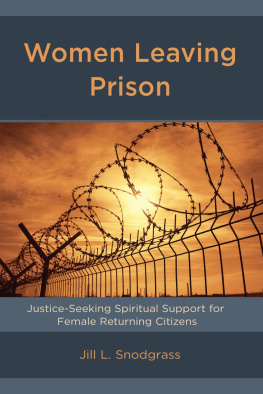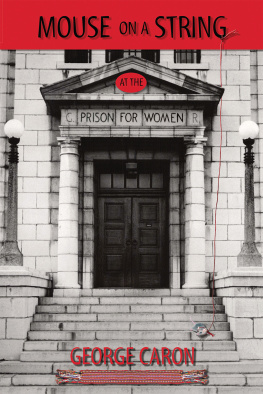
George Caron
(Courtesy Corrections Service Canada Museum)
MOUSE ON A STRING
AT THE
PRISON FOR WOMEN

GEORGE CARON



GENERAL STORE PUBLISHING HOUSE INC.
499 OBrien Road, Renfrew, Ontario, Canada K7V 3Z3
Telephone 1.613.599.2064 or 1.800.465.6072
http://www.gsph.com
ISBN 978-1-897508-33-6 (pbk.)
978-1-77123-239-5 (EPUB)
978-1-77123-240-1 (MOBI)
978-1-77123-251-8 (PDF)
Copyright George Caron, 2014
Illustration of mouse: Dina Caron
Cover art, design: Magdalene Carson
Printed by Image Digital Printing Ltd. dba The IDP Group
Printed and bound in Canada
No part of this book may be reproduced, stored in a retrieval system, or transmitted in any form or by any means without the prior written permission of the publisher or, in case of photocopying or other reprographic copying, a licence from Access Copyright (Canadian Copyright Licensing Agency), One Yonge Street, Suite 800, Toronto, Ontario, M5E 1E5.
Library and Archives Canada Cataloguing in Publication
Caron, George, 1943
Mouse on a string at the Prison for Women / George Caron.
ISBN 978-1-897508-33-6
1. Prison for Women (Kingston, Ont.). 2. Women prisoners--Ontario--Kingston. I. Title.
| HV9508.K56C35 2009 | 365.430971 | C2008-908093-9 |
For Frank W. Anderson, who greatly influenced me and encouraged me to enter adult corrections.
Contents
Prologue
The Prison For Women, in Kingston, Ontario, operated as Canadas only female maximum security prison from 1934 to 2000. During the span of sixty-four years, many inmates and staff have had a journey through the prison and experienced a new reality that touched their lives and shaped their futures. Some inmates and staff members spent a relatively short period at the prison, while others had to endure many long years. The memories are not all painful. There were times when inmates and staff laughed together and cherished positive experiences.
Over the six decades, there have been many interesting characters who served time at the institution. A few inmates had high profiles that were ceremoniously bestowed on them by various forms of the media, including print (newspapers and books), radio, television, and motion pictures. High-profile inmates like Evelyn Dick, Marlene Moore, and Carla Homolka captured the interest of many Canadians.
From time to time, the makeup of the inmate population would change, attracting new and different segments that influenced how the prison functioned. For example, during the Second World War, some German female aliens were housed at the institution. The 1950s population included females incarcerated for abortion. During the sixties and early seventies, inmates with serious heroin addictions, mostly from Western Canada, found themselves at the prison after convictions for drug-related offences. During the 1960s to the early 1980s, Doukhobor inmates were transferred to the prison. In the eighties, inmates convicted of offences against small children were admitted, and their numbers increased.
It is a sad reality that over the past thirty years, a significant percentage of the population have had Aboriginal backgrounds. Finally, during the last two decades of the prisons existence, the population profile included younger and younger inmates, many convicted of serious violent crimes. The number of inmates serving long sentences and life sentences for murder continued to grow.
I worked at the Prison for Women during the seventies and eighties. My memory bank is filled with the encounters with numerous inmates and staff who influenced my world. Staff at times have a difficult job to do. There is considerable stress that can affect their performance. Equally, inmates have no place to hide and conceal their inner pain. At times I cant stop thinking and reminiscing about the inmates and staff that I had the privilege to supervise and work with at the prison. I am indebted to all the staff and inmates that entered my life.
The different stories and vignettes that I have written about were prompted by actual occurrences. At times I have liberally dramatized the events; it was difficult to stop my imagination from spilling over reality. Sometimes the brutal facts of incarceration revealed the pus and poison that oozes from the unfolding of events and tragic circumstances. I apologize for sometimes portraying events later than they actually occurred or earlier than they were reported.
I have deliberately changed the names of the inmates and staff that were present during my years at the Prison for Women, for obvious reasons. In some instances, I did not change the location where selected inmates were arrested or committed their crime; consequently, it would not be difficult for some inmates to identify themselves. I attempted to be as accurate as possible in reporting the actual events.
I am thankful for the interactions that I experienced with inmates and staff alike. Sometimes, as warden, I had to make difficult decisions that may have been perceived as being too direct and personal. I hold no bad feelings toward any inmates or staff. There were some inmates whom I could not reach or communicate with. In all cases, deep down, I wanted inmates to be successful and live meaningful lives when they returned to the community, without too much hurt or pain from unhappy times. Unfortunately, the inner pain that some inmates had experienced was too great and followed them throughout their lives. I wish there could have been more positive outcomes for the inmates that served time at the prison. I would have liked to see them improved and transformed. It is so rewarding when an inmate changes her life, contributes to the community, and fulfills her goals with happy conclusions.
It is extremely gratifying to acknowledge the gifted people that helped me complete this story. I want to express my thanks to Mary Smith for reviewing my entire manuscript and offering suggestions to improve the document. I would also like to thank Hilton Murray and Sharon Mitchell for their insightful comments on reading portions of the first few chapters of the book. I am especially grateful to my friend Mrs. Marg Ruttan, who was Chief of Health Care during my tenure as warden. Mrs. Ruttans helpful comments and knowledge about the personalities in the prison helped to shape the framework for this book. Her contribution was most significant and beneficial to me in telling the stories that fill the pages of this book.
I am indebted to David St. Once, the curator of the Correctional Services of Canadas Museum at Kingston, Ontario, for his assistance in obtaining archival material on the Prison for Women.
I would be remiss if I failed to acknowledge Sara Lyman for her intelligent editing skills and suggestions for improving the manuscript. And thanks to Frank Anderson, who had been aware of my plan to write this book for many years; his inspiration helped me to complete this task.
I was fortunate to have three gifted mentors and supervisors during my years in adult corrections who helped to increase my knowledge and understanding of the complex lives of parolees, inmates, and staff experiencing adult penology. My predecessor and former warden; my first supervisor, Mr. Robert Gillies, former District Director of the Edmonton Parole Office; and Mr. Arthur Trono, Deputy Commissioner of the Ontario Region Correctional Service of Canada. These gentlemen were truly good role models and an inspiration to me.












